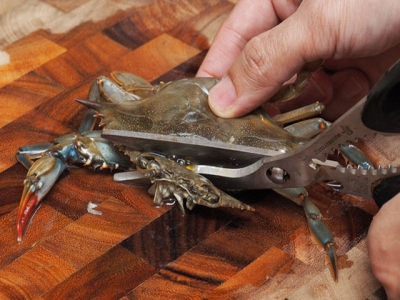How to Clean Soft-Shell Crabs

Pity the feisty blue crab. Even its binomial name,Callinectes sapidus ("savory, beautiful swimmer"), spells its fate. Hard shells and skin-splitting pincers aren't enough to stop us humans from throwing a bunch of them in a pot with Old Bay, then messily picking them to shreds in search of morsels of sweet, tasty meat.
A step-by-step guide to properly cleaning soft-shell crabs.
Pity even more the soft-shell blue crab, which has shed its protective shell during the growing months of roughly May through September, so that it can form a new, larger one. Not only is the soft-shell defenseless, with its limp claws and squishy carapace, it's also irresistibly easy to eat, requiring nothing more than a quick cleaning of a few inedible parts to prepare it for cooking and eating whole.
Pity, also, the cook, who has to slaughter the soft-shell crab in what feels like the most brutal way possible: by cutting off its face, ripping free its abdomen, and tearing out its lungs (technically gills, but I'm anthropomorphizing here). Some will object to this on ethical grounds, while others will choose to have their fishmonger do it for them. But for those of us who like our shellfish alive until the last moment—which should be all of us—here are the basic steps to get these crabs ready for the frying pan.
(What's sad, by the way, is the almost heroic way in which the crab's molting starts out: In an Incredible Hulk–like shirt-shredding maneuver, it takes in enough water to swell its body up and crack the hard shell, but then, instead of a fearsome monster emerging, out slithers a flaccid creature, which then tries to hide long enough to absorb calcium from the water to harden its new shell. If it's plucked from the water before that happens, the shell won't harden.)
Soft-shell crabs need to take a lesson from Bruce Banner, because saying "Don't make me angry - I wouldn't be able to do a damned thing to you even if I were angry" isn't very intimidating.
Starting Out
Like most shellfish, dead crabs decompose rapidly as marine bacteria break down the flesh, eventually producing an unpleasant ammonia odor. Be sure to buy live ones that still have a bit of vigor (not rigor!) in them, though it's important to note that refrigerated live crabs are often less animated, yet no less alive. It's fine to have your fishmonger clean them for you, but again, your best bet is to keep them alive as long as possible. Store them in your refrigerator until you're ready to cook, but don't hold on to them too long—the crabs will weaken and expire on their own without food, water, and all the other things they need to survive. It's therefore best to buy them the day you plan on cooking them. Storing lively ones overnight in the fridge should be fine as long as they're in a moist environment and are able to breathe, but I wouldn't recommend trying to keep them any longer than that.
A quick rinse under cold running water can help remove any dirt or debris clinging to the crabs.
For more basic info and buying tips for soft-shells, check out our beginner's guide here.
Cut Off the Face


The first step is to, shall we say, deface the crab. I like to use a good pair of kitchen shears for this, but a sharp knife will work in a pinch; just not a soft-shell pinch, because those floppy claws are good for nothin'. Using the shears or knife, cut across the front of the crab, just behind the eyes and mouth parts, in order to remove them—these should all come off in a single, approximately quarter-inch-wide strip.
Remove the Gills




Now lift one of the corners of the top shell to expose the nasty-tasting gills, which look like beige, pointy, frilly little tongues. Grab the gills and rip them all out at the base. Repeat on the other side of the top shell.
Pull Off the Apron





Finally, turn the crab over to expose its underside. There you will find a flap known as the apron. On male crabs, it will be long and thin; on females (as shown here), it will be wider. Lift the apron with your fingers, and pull it off the body. It should come free fairly easily.
Now your crabs are ready to be cooked and eaten in (what remains of) their entirety. If you're looking for a recipe, try one of the three great ones attached here.
At this point, please dispense with the pity party and enjoy!
About Author:
Daniel cooked for years in some of New York's top American, Italian and French restaurants - starting at the age of 13, when he began staging at the legendary restaurant Chanterelle. He spent nearly a year working on organic farms in Europe, where he harvested almonds and Padron peppers in Spain, shepherded a flock of more than 200 sheep in Italy, and made charcuterie in France. When not working on, thinking about, cooking and eating food, he blows off steam (and calories) as an instructor of capoeira, the Afro-Brazilian martial art.
Related news
 Oils with high SFA levels may support aqua feed fish oil reduction
Oils with high SFA levels may support aqua feed fish oil reduction Use of lipid sources with high levels of saturated fatty acids may support fish production and omega-3 levels in farmed fish fed diets with no fish oil
 Vietnam sees strong growth in aquatic exports to US
Vietnam sees strong growth in aquatic exports to US Vietnam enjoyed a surge of 46 percent in aquatic products’ export value to the US market in August to 188.7 million USD
 Domestic seafood sales hindered by administrative procedures
Domestic seafood sales hindered by administrative procedures Local seafood enterprises find it difficult to supply their products to the domestic market due to obstacles in administrative procedures